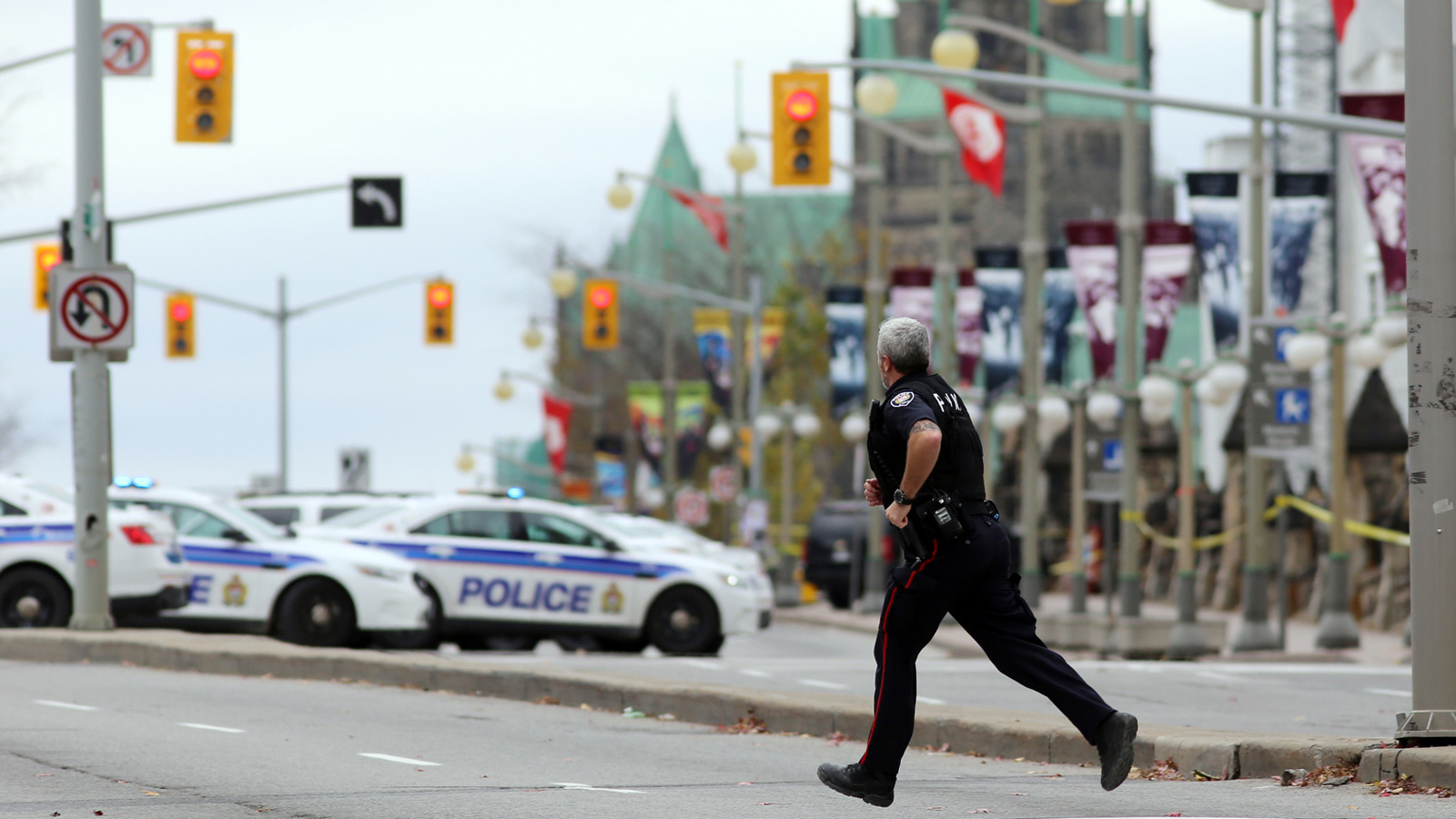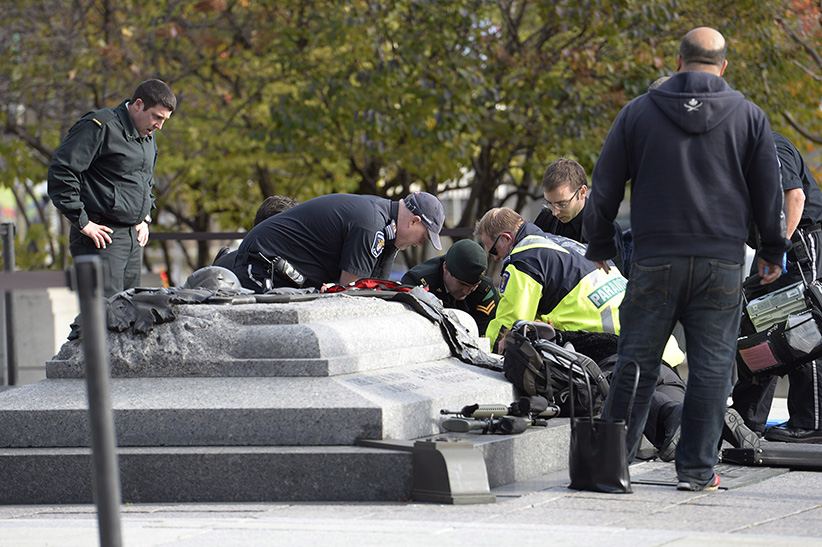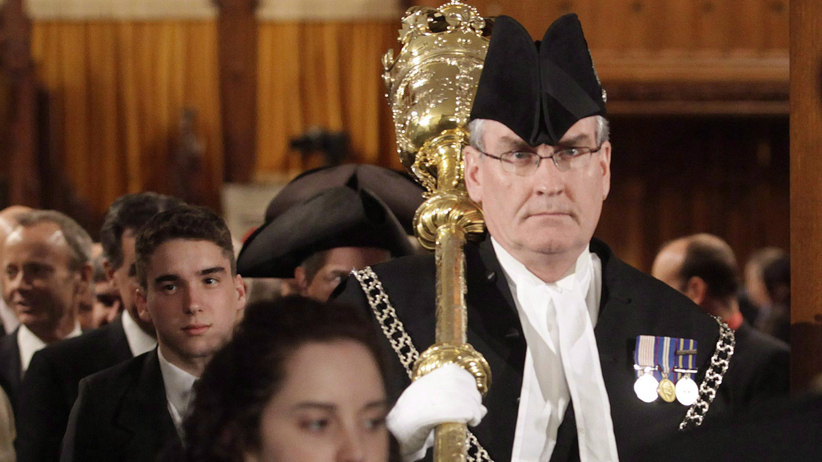Ottawa shooting: How the terror unfolded
A tragic shooting on Parliament Hill has left one soldier dead and a nation in shock. How did it happen? And what does it mean for Canada?
(Photo by Mike Carroccetto/Getty Images)
Share

Addressing the nation this evening, Prime Minister Stephen Harper condemned the “despicable attacks” on Canadian soil this week, but vowed national resolve.
Linking this morning’s shooting in the nation’s capital with the attack on two members of the Canadian Forces in Saint-Jean-sur-Richelieu, Que. on Monday, Harper said that Cpl. Nathan Cirillo, struck down while guarding the National War Memorial in downtown Ottawa, was “murdered in cold blood.” ”
“Fellow Canadians, in the days to come we will learn more about the terrorist and any accomplices he may have had. But this week’s events are a grim reminder that Canada is not immune to the types of terrorist attacks we have seen elsewhere around the world,” Harper said in a televised address. “We are also reminded that attacks on our security personnel and on our institutions of governance are by their very nature attacks on our country, on our values, on our society, on us Canadians, as a free and democratic people who embrace human dignity for all.”
Harper said Canada would redouble its efforts to combat global terrorism.
“We will not be intimidated. Canada will never be intimidated. In fact, this will lead us to strengthen our resolve and redouble our efforts and those of our national security agencies to take all necessary steps to identify and counter threats and keep Canada safe here at home. Just as it will lead us to strengthen our resolve and our redouble our efforts to work with our allies around the world and fight against the terrorist organizations who brutalize those in other countries with a hope of bringing their savagery to our shores. They will have no safe haven,” Harper said.
“While today has been, without question, a difficult day, I have every confidence that Canadians will pull together with the kind of firm solidarity that has seen our country through many challenges. Together we will remain vigilant against those at home or abroad who wish to harm us.”
Speaking after the Prime Minister, NDP leader Thomas Mulcair, leader of the official opposition, said today’s attack had failed to deter the country.
“Today, the peace of our nation’s capital was shattered by an act of hatred and brutality. A cowardly act, designed to strike at the very heart of our democracy— at the heart of who we are. But I stand here tonight in solidarity— side-by-side with my colleagues, with our Prime Minister and with all Canadians,” he said.. “This attack struck with sudden and deadly violence. It was carried out on the very ground where we come together to exchange ideas with the knowledge that whatever our differences we will always resolve them peacefully. It was intended to make us more fearful of our neighbours and less confident in ourselves. But it has failed. Today’s events have instead only succeeded in drawing us closer, in making us stronger.”
The attack—calculated and cold-blooded—started at 9:51 a.m on Wednesday morning. A Canadian Army reservist, standing guard at the National War Memorial in Ottawa, just steps away from Parliament Hill, was taken unawares. Shot at close range by a man wearing a hoodie and a three-quarter-length coat, his face partially obscured by some sort of blue and white scarf, the reservist crumpled to the pavement. His assailant jumped into a car and sped off.
Matthew Blais, a construction worker, was waiting outside the nearby East Block, which houses offices for MPs and senators. He witnessed the shooting and the terror that followed. “From what I seen, he was trying to hunt people down and get them really quick,” he said. “I just heard so many shots, I couldn’t put a count on it.” Pedestrians scattered. Blais saw a body fall to the ground.
Within seconds, another soldier who was also standing guard at the cenotaph was at the wounded reservist’s side and began performing CPR. A woman who was passing by began artificial respiration. A photo that was posted on social media captured a jumble of backpacks, briefcases and military rifles resting on the tomb of the unknown soldier as a growing crowd tried to save him. Police and paramedics arrived and took over the efforts. The young man, later identified by family as Cpl. Nathan Cirillo, a member of Hamilton Ontario’s Argyll and Sutherland Highlanders regiment, was eventually loaded into an ambulance, as first responders continued to pump his heart.
But, by then, the fear had spread to the House of Commons itself. The cenotaph shooter, identified by American sources as Michael Zehaf-Bibeau, a 35-year-old Canadian of Algerian origin, drove barely 100 m before he abandoned his car—a beat-up, beige Toyota Corolla, without any plates—on Wellington Street, just outside the East Block gate to Parliament Hill. Grasping a rifle, or perhaps a shotgun (witnesses differ), he ran up the steps onto the lawn.

Scott Walsh, who was working at a manhole just inside the gates to install fibre-optic cables for Parliament, heard the shots and saw the crowd running. A woman, pushing a stroller and child, was screaming. He moved to help her, then saw the gunman. “We saw a man with a mask over his face—well, a scarf; long black hair; he was wearing blue pants and a black jacket and he had a double-barrelled shotgun,” said Walsh. His colleague, Barry Willis, came almost face-to-face with the shooter. “It seemed surreal, for a second. And then the rifle came up—it was right at me.” Willis dove behind his van.
Another bystander—a man in a three-piece suit—took shelter inside it. The gunman pointed his weapon at a car parked outside of the East Block, within Parliament’s secure perimeter. “He forced the driver out and pointed the gun at his head,” said Willis. “The guy got out, got on his knees and I thought, ‘That sucker is getting his head blown off,’ because the rifle was right at his face.” Instead, the shooter took the car and drove the short distance up the driveway to Centre Block, Canada’s House of Parliament. Willis did the only thing he could think of. “I just started screaming, ‘Terrorist! Terrorist!’ Everybody down! Everybody down! Everybody down!” His co-worker Walsh looked back down toward the road and saw another man standing by the fence, dressed almost identically to the shooter. “He had the same type of scarf, but he didn’t have a weapon on him that I could see,” he said. “I popped back over the fence, because somebody was screaming that he was involved, and that’s the last time I saw him.” Other witnesses reported the man might have been driving the Corolla when the car pulled up next to the War Memorial.
The shooter entered Centre Block through its main public entrance, right underneath the Peace Tower, just before 10 a.m. Early reports suggested he shot and wounded a security guard just inside the doors, then crossed the main rotunda and headed down the Hall of Honour, toward the Library of Parliament. A cellphone video, shot by a Globe and Mail reporter, captured more than a dozen police officers following in the man’s wake, their handguns drawn. As they made their way down both sides of the corridor, taking shelter behind pillars, a loud shot rang out. In response, the police opened fire. The video captures somewhere in the neighbourhood of 25 to 30 shots. But it appears the suspect may already have been dead by that point, felled by the first shot, reportedly fired by Kevin Vickers, the House of Commons’ sergeant-at-arms. The 58-year-old Vickers, a 29-year veteran of the RCMP, has a handgun in his office, which is located just down the corridor past the library. An imposing figure, standing close to six foot four, Vickers has been in charge of security on the Hill since 2006, though he forged his reputation as a peacemaker, helping to settle a volatile dispute with Native fishermen in Burnt Church, N.B., in 2000. During his time in Ottawa, he has been a proponent of keeping the Parliament buildings as open and public as possible. In 2010, after Quebec’s National Assembly banned kirpans, the ceremonial dagger carried by many observant Sikh men, Vickers was quick to make sure there would be no similar move on the Hill. “I told them that if they made me their sergeant-at-arms, there would be no walls built around Canada’s Parliament buildings,” he said later. “And the fact that you may wear your kirpans within the House of Commons proves there are no walls . . . and I have kept my promise.”
As the drama unfolded, almost all of Canada’s 308 members of Parliament were gathering in meeting rooms, directly off the Hall of Honour for their weekly party caucuses, which traditionally start at 10 a.m. Panic followed the sound of gunfire. NDP members barricaded the door to their room with the heavy, wooden, green-leather chairs that are used throughout the building. “MPs and Hill staff owe their safety, even lives, to Sergeant-at-Arms Kevin Vickers, who shot the attacker just outside the MPs’ caucus rooms,” Craig Scott, MP for Toronto-Danforth (former NDP leader Jack Layton’s former riding) tweeted later.

Kirsty Duncan, the Liberal member for Etobicoke North, had just entered her caucus when another Toronto-area MP, Judy Sgro, ran up and shouted that they had to leave. Moments later, Hill security staff arrived and hustled them outside to the lawn behind the building. Just then, the shots rang out, and the air filled with the smell of gunpowder. Duncan saw traumatized staffers piling out of the library’s rear exit. An armed police officer arrived and asked for help finding his way into the building. After a half-hour or so, more officers arrived and told the milling MPs and staffers to leave the lawn and find a secure place to hide. There were unconfirmed reports of more shooters stalking the Parliament buildings. There were also suggestions that a third shooting had taken place outside the Rideau Centre, a shopping mall just down the road. Duncan took shelter in her office in the nearby Confederation Building. Hours later, she was still there, behind a locked door and staying away from the windows. “You want to know your colleagues are safe,” she said over the phone, sounding shaken. “I want to know that the security guards who keep us safe every day are okay. All the young tour guides and the pages, are they okay?”
Karl Bélanger, the principal secretary to NDP Leader Thomas Mulcair, was reached on the phone in the office of Guy Lauzon, the Conservative MP from Stormont-Dundas-South Glengarry. “You called a Conservative MP’s office, but I’m the one who picked up the phone,” he said. “That’s just the way it is right now on Parliament Hill, everybody united in the face of this tragedy.”
Canada’s terrorism-security-watch level had been raised from low to medium, only one day before the Ottawa attack, after a Quebecois convert to Islam, Martin “Ahmad” Couture-Rouleau, used his car to run down two soldiers in Saint-Jean-sur-Richelieu, Que., about 50 km southeast of Montreal. Patrice Vincent, 53, a 29-year veteran of the Canadian Forces, died from his injuries. Another soldier remains in hospital. Couture-Rouleau, 25, was killed by police after he rolled his vehicle on a nearby highway and refused to surrender. The government had said the raised terror warning was in response to “general chatter,” rather than a confirmed threat. Couture-Rouleau, who had tried to fly overseas this past summer to join opposition fighters in Syria, was reportedly inspired by radical groups like Islamic State. He was among the 90 would-be Islamic radicals currently under surveillance by Canadian police and intelligence officials.
Related:
LIVE BLOG: Updates on the Ottawa shooting as details emerge
Parliament Hill shooting leaves soldier, 1 suspect dead
Ottawa shooting: Photos from the scene
Interactive timeline: What happened in Ottawa
In Ottawa, amid fears that the shootings at the cenotaph and on the Hill might be part of a wider plot, dozens of buildings were locked down, including all government offices, the U.S. embassy and the historic Château-Laurier hotel. The campus of the University of Ottawa was closed. Military bases across the country were put on high alert, and security was increased at provincial legislatures. Prime Minister Stephen Harper, Mulcair and Liberal Leader Justin Trudeau were all evacuated to secure locations. And an NHL game between the hometown Ottawa Senators and the Toronto Maple Leafs scheduled for Wednesday night was postponed. U.S. President Barack Obama and the Prime Minister conferred by phone. The President “expressed the American people’s solidarity with Canada in the wake of the attacks,” and the deaths of the two soldiers, the White House said in a press statement. Obama “condemned these outrageous attacks, and reaffirmed the close friendship and alliance between our people,” it concluded.
It wasn’t until shortly before 1 p.m. that confirmation came of the reservist’s death. Jason Kenney, the minister of employment and multiculturalism, was the first to tweet the news. “Condolences to family of the soldier killed, & prayers for the Parliamentary guard wounded. Canada will not be terrorized or intimidated.” Another MP reported he and fellow Tories had observed a moment of silence. At the regimental headquarters in Hamilton, mourners had left flowers and a crucifix made from roses at the entrance. There was no name on the cross, only the words “lest we forget.”
Although government buildings remained in lockdown for most of the day, it appeared that the threat has passed. Still, at a mid-afternoon press conference, Ottawa Police Chief Charles Bordeleau asked people to stay away from the downtown core and suggested that the security perimeter around Parliament Hill would be up for some time. He refused to confirm or deny whether the authorities are seeking other attackers. “We’re in the process right now with the RCMP in clearing and securing Parliament hill. That’s a slow, methodical approach,” said Bordeleau. “What we are asking the community is to continue to be aware, to be vigilant, and to report any suspicious activity that could impact their safety . . . and suspicious activity that may identify any individual that may want to cause harm to fellow Canadians.”
The wounded parliamentary security officer, who was shot in the leg, was reported to be in stable condition in an Ottawa hospital. So, too, was another person who was injured in the scramble near the cenotaph.
The motives behind the attack were still unknown on Wednesday afternoon, although most believe it to be an act of terror. There are obvious echoes of the foiled 2005 plot by the so-called Toronto 18 against Parliament. Yet, little suggests the shooter was a professional. If he had been, it’s certain many more victims would have died.
But already, there is concern that life in Ottawa and the nature of Canadian democracy has been altered. “I think our days of innocence ended today,” said Sen. Jim Munson, a former television journalist. “I think that we’re going to look at a situation on Parliament Hill, which you see most of the time at Westminster and Capitol Hill—men and women with machine guns—and I think that will become part of our daily lives. And I guess we’re going to have to learn to live with that. I guess we’ve lived in an environment where we thought the ocean would separate us from all of these troubles, but not anymore.”
Any tightening of security is likely to spark detailed argument about how to differentiate between visitors to the Hill, who might pose a threat, and MPs, senators and staffers, or even parliamentary press gallery journalists, who are used to coming and going with minimal attention from security officers.
John McKay, a Toronto-area Liberal MP, lamented what he presumes will be the end of Ottawa’s openness. But he expressed hope that the coming cloistering will end at Parliament Hill. “I hope we don’t yield to paranoia. I hope that, somehow or other, we protect our democracy,” he said. “We have a tremendous country. If you travel the world, we’ve got it pretty darn good here.”
—with files from Aaron Wherry, Paul Wells, Michael Petrou, John Geddes, Anne Kingston, Murad Hemmadi, Dan Robson, Brett Popplewell and Charlie Gillis